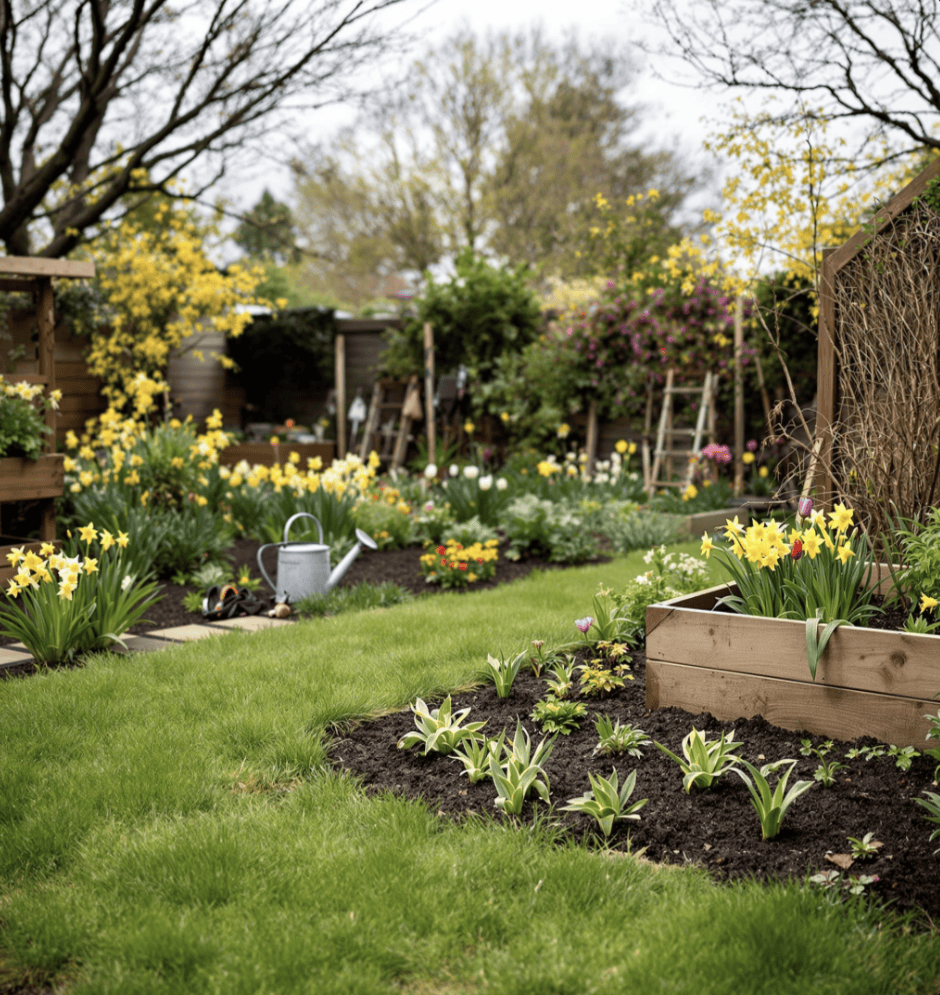
Overview
Gardening preparation for spring is an essential part of setting your outdoor space up for a successful season. As the frost fades and days grow warmer, now is the perfect time to clear, tidy, and start planting to bring your garden back to life.
Whether your garden is a blank canvas or simply in need of a seasonal tidy-up, here are a few ways to get it back in shape this spring.
Start with a General Clear-Up
Before diving into planting, take time to clear away the debris winter has left behind. Remove fallen leaves, prune back dead branches, and tidy up borders and beds. Giving everything a good once-over now makes space for new growth and helps prevent pests and disease from settling in.
It’s also a good time to assess any areas that may have become damaged by frost or wind. Broken fence panels, sagging trellises, and cracked pots are all worth sorting early in the season so you can focus on planting and enjoying the space later.
Prepare the Soil
Spring is when your soil starts to come alive again. Loosen it with a fork or spade and work in compost or organic matter to enrich it. This not only feeds your plants but also improves drainage and aeration, both of which are essential for strong root development.
If you’re unsure about your soil type or quality, a simple pH test kit can help guide you towards the right plants or amendments. Taking the time to build healthy soil now will reward you with stronger, more resilient growth throughout the season.
Don’t Forget About Seeding
Spring is one of the best times to sow seeds—either directly into the ground or in trays under cover. Starting from seed allows you to grow a wide range of flowers and vegetables, often more affordably and with greater variety than buying young plants.
For flowers, consider sowing calendula, nigella, cosmos, cornflowers, and marigolds. These can often go straight into the soil once the risk of frost has passed.
For vegetables, early crops like lettuce, rocket, carrots, radishes, and peas can be sown outside now. Warm-loving plants such as tomatoes, courgettes, and beans should be started indoors or in a greenhouse before planting out later in the season.
Make sure soil is warm and crumbly before sowing, follow spacing guides, and water gently but regularly. If you’re unsure where to start, we’re happy to help prepare seedbeds or get your seedlings off to a strong start.
Plan Your Planting
Some gardeners rush to plant at the first sign of sunshine, but early planning makes all the difference. Think about what you want to achieve—whether it’s colour, structure, or something edible—and choose plants that suit your soil and the amount of sunlight your garden receives.
At this time of year, it’s safe to start planting:
-
Hardy annuals like sweet peas, calendula, and cornflowers
-
Perennials such as delphiniums, lupins, and hardy geraniums
-
Vegetables including carrots, onions, spinach, and early potatoes
Prune with Purpose
Pruning in spring helps shape your plants and encourages strong new growth. Cut back any winter-damaged shrubs and trim plants like roses before they start to bud. Be sure to use clean, sharp tools and always check the specific needs of each plant before pruning.
If you’re unsure where to begin, start with dead or damaged stems, followed by thinning out overcrowded growth. Many plants benefit from a good tidy in early spring, setting them up for a stronger and more balanced summer display.
Check Your Garden Tools
Before the growing season gets underway, it’s worth checking over your tools. Give everything a clean to remove any rust or residue, and sharpen blades where needed—especially on pruners, shears, and spades. Clean, sharp tools make gardening easier and reduce the risk of damaging your plants.
This is also a great time to get organised. Clear out your shed or storage space, replace anything that’s broken or missing, and make sure everything you need is easy to find. Starting the season with tools in good condition saves time and frustration later.
Mulch Where You Can
Adding a layer of mulch to garden beds in spring is one of the easiest ways to protect your soil and help your plants thrive. Mulch helps retain moisture, reduce weed growth, and regulate soil temperature. It also slowly breaks down over time, feeding the soil naturally.
You can use bark chips, compost, leaf mould, or well-rotted manure, depending on the look and needs of your garden. Apply mulch once your soil has warmed slightly and after any early planting is done. It gives borders a neat finish and supports healthier growth in the months ahead.
Look Ahead to Summer
Use this quieter period to plan ahead. Think about how your garden will evolve over the season—what blooms when, where shade will fall, and how you want to use the space. Spring is also a good time to install new features like raised beds, trellises, or water butts, while the ground is soft and manageable.
If you’re planning to host garden gatherings, add outdoor seating or lighting, or grow your own food, now is the time to start laying the groundwork. A little foresight in spring can lead to a much more enjoyable summer outdoors.

